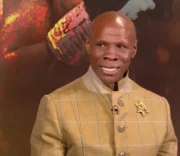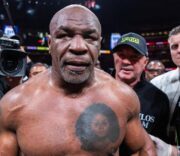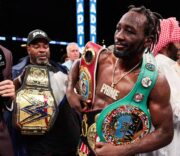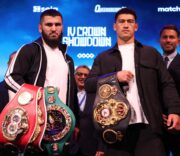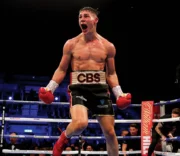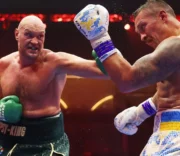
In the high-stakes game of boxing, competitors often seize every opportunity for greatness—even if that means shifting weight classes significantly to go toe-to-toe with a new caliber of opponents. Notably, Jermell Charlo’s upcoming bout with Saul Alvarez marks such a daring move, and it signals a revival of a boxing tradition that may just be redefining the modern sport.
Setting the Stage: The Charlo-Alvarez Matchup
On September 30th, Jermell Charlo is slated to face off against Saul Alvarez in a transition from junior middleweight to super middleweight—a bold leap across two weight classes and a fourteen-pound difference. Such a transition isn’t just audacious; it’s downright fascinating. And if the chatter is anything to go by, Charlo won’t be the only one making this leap. Terence Crawford, the undisputed welterweight champion, may be eyeing the victor of this matchup for his own big scale jump.
The Historical Precedence: It’s Not a New Phenomenon
While this strategy may appear risky and unconventional, it’s far from unheard of.
The Allure of “Ceiling Chasing”
“Conquering the scale in boxing is not a must for greatness…How far can they go is a question that has always sparked the imagination,” — BoxingScene
The boxing greats — like Willie Pep, Carlos Monzon, and Marvin Hagler — established their legends without ever jumping weight classes. However, the spectacle of a boxer challenging the limits of their potential weight class creates a tantalizing narrative.
The Rich History of “Scale Jumpers”
In fact, this trend has historical roots. From Mickey Walker’s failed attempt against Tommy Loughran to Sugar Ray Robinson’s nearly successful bout with Joey Maxim, the allure of ‘breaking the scale’ has deepened the stories of many an athlete.
| Famous Boxer | Original Weight Class | Attempted Jump | Success or Failure |
| Mickey Walker | Welterweight | Light Heavyweight | Failure |
| Sugar Ray Robinson | Middleweight | Light Heavyweight | Failure |
| Dick Tiger | Middleweight | Light Heavyweight | Success |
Long-Standing Audacity
This brand of audacity — of defying weight class restrictions — has been sprinkled throughout the careers of legendary fighters like Sam Langford, Harry Greb, and James Toney. In their cases, these fighters even took on heavyweights while not far off from their original middleweight stature.

The Evolution of Weight Classes: An Expanding Landscape
Over the past few years, boxing has seen a transformation that has broadened the arena for dramatic moves like the one Jermell Charlo is contemplating. One of the significant shifts lies in the rules surrounding weight classes, which have grown more flexible, offering a wider pathway for boxers to make such audacious leaps. This isn’t just a vague possibility but a structured opportunity, in part thanks to changes like pre-fight weigh-ins. These weigh-ins typically happen a day before the match, providing fighters a chance to regain some of the weight they shed for the weigh-in, thereby entering the ring with a bit more muscle and bulk.
Adding to the feasibility of these weight class jumps is the proliferation of titles across the boxing world. There are now more belts and honors to strive for, so boxers can afford to look beyond their immediate weight class without going too far out of their comfort zones. The availability of multiple titles across divisions offers a calculated risk for those willing to stretch their limits and take on bigger, more daunting opponents.
Yet, this is not to downplay the inherent risks and rewards of such a decision. Taking a leap of faith into a higher weight class is fraught with dangers as much as it promises glory. Success stories like Bernard Hopkins, who not only stepped up but triumphed over Antonion Tarver at a mature age, serve as inspirations.
“The audacity is, or would be, part of the fun,” as articulated by BoxingScene, perfectly captures the allure.
However, failure comes with its own set of repercussions, including potential dents in reputation and marketability that could take years to rebuild.
The Charlo vs. Alvarez match isn’t just an isolated episode; it could potentially be a harbinger of things to come in the boxing community. Terence Crawford, another eminent boxer, has also shown interest in following suit. He’s been surrounded by rumors of possibly taking on the winner of the Charlo-Alvarez bout, signaling that this might not be a one-off event but the beginning of a new norm. As it stands, the forthcoming match will not only measure Charlo’s capabilities but could set the tone for the next wave of multi-class bouts, maybe even ushering in an era that embraces these leaps as integral elements of modern boxing.
A Riveting Narrative
Weight class jumps aren’t just about the spectacle; they offer a deeper insight into the psyche of a boxer. The question for September 30th isn’t just whether a junior middleweight can beat a super middleweight, but rather, if this particular junior middleweight — Charlo — can redefine his legacy against a formidable opponent like Alvarez. And in a sport that thrives on its compelling stories, this trend only makes boxing all the more riveting.





